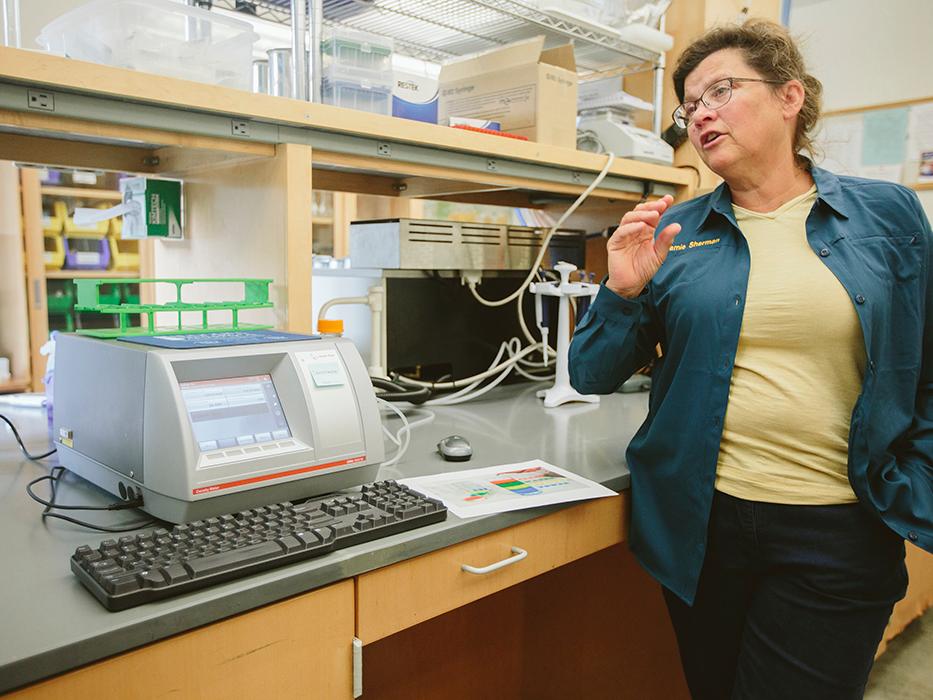By Meghan Howes, Contributing Writer for RadCraft

Long before the term “craft malt” entered the beer industry’s imagination, enterprising scientist Dr. Jamie Sherman was breeding and testing barley and other grains. Working within Montana State University’s (MSU) Department of Plant Sciences and Plant Pathology, Sherman studied the composition of several grains in an attempt to better understand the genetics behind malt quality: its drought tolerance, pest tolerance, and hardiness, among other factors. “Research goes on constantly,” remarks Sherman. “We’re always analyzing data – in the fall, we process the material from the test plot, get the data together, analyze it, and then decide what will move forward and what will be eliminated.”
Montana State plants barley all over the state – some is planted in early March, others hit the dirt later in the spring. After careful observation, Sherman starts thinking about how she can improve upon the product even more. She makes new barley crosses in the fall and winter months, and those eventually go back into the fields. “Most plots are about three feet wide by 15 ft long. That size allows us to get a big enough batch to malt, usually about 150-200 grams.” The team selects from these plots as early as possible so they can test it, process that data, and start breeding again.
“You think you know what’s going to happen with the crosses,” Sherman said, “but each cross I make is an experiment. One of the things I like the most is to observe the crosses I’ve made in families – I can look across the whole family and then see the diversity in that family and I pick what I think…I want.” In plant breeding, the term “family” refers to a set of individuals resulting from a cross of the same two parents.
Sherman spends a lot of time in the barley fields “sweaty and dirty,” she said with a laugh. A typical day for her as a breeder depends wholly on the time of year. In the spring and summer, Sherman is “out in the field, observing plots, making selections, getting ready for harvesting.” Driving a combine is commonplace. Sherman says they have small plot planters so that “…every single seed, every single row, we know exactly where it came from. We put the siblings together so we can see that diversity in the family. Anything under genetic control can be a breeding issue.”
“For instance,” Sherman continues, “in malting, we have efficiency issues – malting takes about a week. One of the things that has to happen [in that process] is the water needs to get into the seed efficiently. The time it takes to get the water to seed is critical. We’ve identified the crosses that can help with that.” Malt steeping (“hot steeps”) is an important step in the MSU’s analysis, as it allows Sherman and her team in the Barley, Malt & Brewing Quality Lab to get a feel for what the malt is going to taste like. “Hot steeps are done by both maltsters and brewers,” Sherman shares. “We use the method as an educational tool. We’re also doing it scientifically to try and figure out what the flavor compounds are and the genetic control of those compounds. Metabolomic analysis [sheds light on] the chemical complexity of the various varieties.”
Although historically it has been too cold to grow winter barley in Montana, recent warmer winters could make winter barley an option especially with the development of more cold-tolerant barley. Changes in climate and unpredictable weather patterns have created some unforeseen issues for barley breeders. “Heat is a huge issue for barley, even more than drought. We can’t do anything about high temps.” Extreme nighttime temperatures are particularly problematic for barley crops. With temps hitting the high 90s for weeks on end this summer, the state is dealing with one of its driest years on record. “Last year [2020], we had one of the best yields,” Sherman said. “This year we’re stuck with not enough crop to meet demand. Everyone is talking about that as if it’s a given. Because people don’t tend to store barley, there’s not a lot of back-ups. Prices are going up for maltsters.”
Undoubtedly, climate change will impact the whole supply chain, and though Sherman and her team “have focused more on drought, historically…it would be great to try to breed barley to be more heat tolerant. Whether we can modify it is a pretty open area of research.”
Directing time and resources to this “huge problem” means that “we have to go at it in every way possible,” Sherman said. For instance, one of her students is working on a project centered on understanding the genetics behind root growth. “It seems like we’re moving forward in understanding the genes that control the architecture of roots, which could be very helpful.” Ultimately, Sherman sees changes in climate and its effect on agriculture as a global conundrum that requires immediate attention. “The future is NOW,” she said.
Learn more about the testing services and resources the MSU Barley, Malt & Brewing Quality Lab provides on their website and follow them on Facebook, Instagram, and Twitter.



You must be logged in to post a comment.